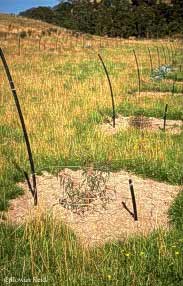|
Weed control

Weed competition is the most important
factor affecting trees’ survival and early growth. In
a farm forest context, a weed is anything that competes with
a young tree for moisture or light. Removing competition—using
chemicals, mulch or cultivation— encourages rapid, early
growth of trees.
The appropriate amount and timing of weed
control depends on the trees’ growth rate and the weed
type. Newly planted seedlings that grow free of weed competition
for a full growing season will usually not require any further
protection from shallow rooted weeds. Weed control in the
second and subsequent years is usually only justified where
tree growth is very slow or where there is extremely vigorous
competition from deep-rooted grasses—such as Phalaris—or
woody weeds.
Farm foresters must consider several
factors before deciding on the most appropriate option for
achieving weed control on their farm(s). These include:
• costs
• labour
• equipment needs
• period of effective control
• risk of environmental hazards.
The most common methods of weed control involve applying a
combination of pre- and post-emergent herbicides prior to
planting. For some tree species—for example.
Pinus radiata—there
are chemicals that do not damage the planted trees which can
be applied over the top of young seedlings to control weeds.
Some farmers have access to free, suitable
mulching material and this is an option if they do not want
to use chemicals. Plastic, carpet or weed matting can provide
effective weed control for more than a year. Organic mulches
like hay or wood chips may be less effective unless regularly
added. In any event mulching remains a very labor-intensive
option.
Planting trees
to reduce the spread of weeds
Back to top
|
